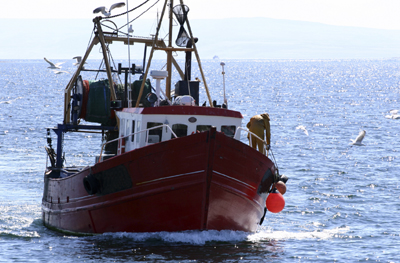Biological Agents
- Risk of infection from handling dead fish or slime on live fish. Injuries from fish bones, scales or fish hooks becoming infected.
|
Chemical Agents
- Risk of asphyxiation, suffocation, fire or explosion from gas leaks e.g. refrigerant gases, methane or propane or leaking cooking appliances.
- Risk of headaches, nausea, dizziness, unconsciousness and death from carbon monoxide exposure due to poorly vented engine exhaust gases, leaks in the exhaust system or inadequate ventilation if using heaters or stoves.
- Risk of dermatitis or ill health due to contact with fuels, hydraulic oils, bleaches, cleaning agents or disinfectants.
- Risk of serious physical injury or death due to exploding batteries.
|
Confined Spaces
- Risk of falling unconscious or death due to oxygen deficiency or toxic atmosphere e.g. working in confined spaces or other watertight compartments with little or no ventilation such as engine rooms, storage compartments, fish holds or wheelhouses. Exposure to gases due to decomposition or bacterial action of some wet fish in the hold.
|
Electricity
- Risk of electric shock, death or fire due to unauthorised access to switchboards and cabinets, overloading of sockets, corrosion of wires exposed to salt water or equipment unsuitable for the work environment. See Marine Notice No. 18 of 2023.
|
Environmental / Climatic Conditions
Risk of:
- Vessel losing reserve of buoyancy, foundering, capsizing or sinking due to being swamped by wind or wave action or combination of both.
- Falling overboard in adverse weather conditions.
- Flooding due to blocked freeing ports.
- Vessel sinking due to collision with floating or submerged objects.
- Skin or eye damage due to ultraviolet radiation from the sun.
|
Equipment / Machinery
Risk of:
- Being pulled overboard in bight of rope especially when launching equipment.
- Vessel listing due to shifting cargo or equipment.
- Rope burns, dislocated fingers, amputations or fractures on hands from handling cables and ropes.
- Entanglement in moving parts such as unprotected conveyor belt nip points or unprotected winch drums, getting snagged in engines or motors.
- Being hit or struck by cables, ropes, fishing tackle or swinging loads.
- Dropping objects on foot.
- Explosions in compressed air systems due to misuse or poor maintenance.
- Vessel flooding due to inability to detect operational leakages due to lack of maintenance / disregard of bilge alarms and pumps or corroded pipes, fractured pipes or failed seals.
- Risk of electrocution, burns, fire, sunburn or being hit by projection of particles due to use of welding equipment such as oxyacteylene and oxygen.
|
Fatigue
Risk of increased vulnerability to accidents due to physical and mental exhaustion, diminished reaction times, alertness and concentration due to:
- Working long hours at sea.
- Working many days in a row (cumulative fatigue).
- Personal factors e.g. lack of sleep or poor quality sleep due to young children, second job, stress etc.
- High job demands or hard physical work.
- Exposure to noisy or vibrating equipment.
- Adverse weather conditions.
|
Fire
Risk of smoke inhalation, burns or death due to:
- Faulty or unmaintained electrical equipment or plant especially in the galley or engine room.
- Carelessness, inadequate kitchens or equipment.
- Hot surfaces and flammable materials e.g. LPG cylinders.
- Oxygen enrichment e.g. leaking oxygen tanks or lines whilst carrying out hot work.
- Illicit smoking.
|
Hot Surfaces or Objects
Risk of burns due to:
- Contact with hot working equipment or unprotected pipework e.g. loss of balance.
- Spillage of hot substances.
|
Hygiene
Risk of health issues such as athlete's foot or eczema due to:
- Lack of space and limited amounts of fresh water.
- Wearing rubber boots.
|
Lifting Gear
Risk of serious physical injury or death due to:
- Being hit by a load or broken line as it recoils.
- Hand or foot becoming stuck in winch drum as gear being hauled back.
- Tripping over a line.
- Failure to maintain equipment.
|
Manual Handling
Risk of sprains, strains or musculoskeletal disorders due to:
- Handling heavy items of equipment or fish boxes.
- Failure to use mechanical handling equipment.
- Bending, stooping, twisting and lifting when handling and icing the catch.
|
Noise
- Risk of hearing damage or loss due to working in high noise areas such as engine rooms or machinery spaces without appropriate personal protective equipment.
|
Overloaded / Unstable Vessel
Risk of vessel sinking due to:
- Excess weight (machinery, nets, trawling equipment, the catch etc.) on vessel affecting vessel freeboard (i.e. distance from waterline up to the deck of the vessel).
- Changing the use of the vessel without seeking expert advice. Alterations in equipment, structure or intended use of the vessel can all affect stability and your safety.
|
Sharps
Risk of cuts, punctures, hand injuries and infections due to:
- Cutting or gutting fish.
- Preparing and splicing ropes.
- Handling catches or fishing tackle.
- Being bitten by fish, cuts or nips from crabs or lobsters or getting caught on a fin or hook.
- Protruding hooks or nails.
- Handling knives, hooks, fish bones, spines, sharp teeth, fins, horns, scales or stingers.
|
Slips, Trips and Falls
Risk of serious injury, man overboard or death due to:
- Wet, slimy or icy surfaces e.g. fish slime on deck, hydraulic leaks, oil or grease.
- Poor housekeeping e.g. badly stowed ropes, nets or equipment.
- Incorrect footwear.
- Inadequate lighting / illumination or poor visibility.
- Movement of the vessel.
- Unprotected access to stairwells.
- Inadequate gangways.
- Lack of edge protection.
- Unsafe systems of work.
|
Vibration
Risk of fatigue, mental stress, inability to concentrate or slower reaction times due to:
- Poor balancing and alignment of machinery.
- Inadequate maintenance of machinery.
|
Working at Height
- Risk of serious injury or death due to leaning overboard, working aloft or working near open hatchways without adequate fall protection.
|

